Amrutha Lounge: Food and Beverage Operations Management Report
VerifiedAdded on 2023/01/03
|12
|3125
|97
Report
AI Summary
This report provides a comprehensive analysis of food and beverage operations, focusing on the management strategies and challenges within the industry. It begins with an introduction to the field, emphasizing the importance of understanding competition, market sectors, and management techniques. The report then delves into the specifics of Amrutha Lounge, a restaurant in London, UK, examining different business types, rating systems, and current and future trends in the industry. The main body of the report includes a detailed comparison of various food and beverage business models, exploring their advantages and disadvantages. It also covers the factors influencing consumer decisions, such as pricing, brand reputation, and location, and analyzes strategies to attract and retain customers. The report concludes with a summary of key findings and offers insights into the dynamic nature of the food and beverage sector.
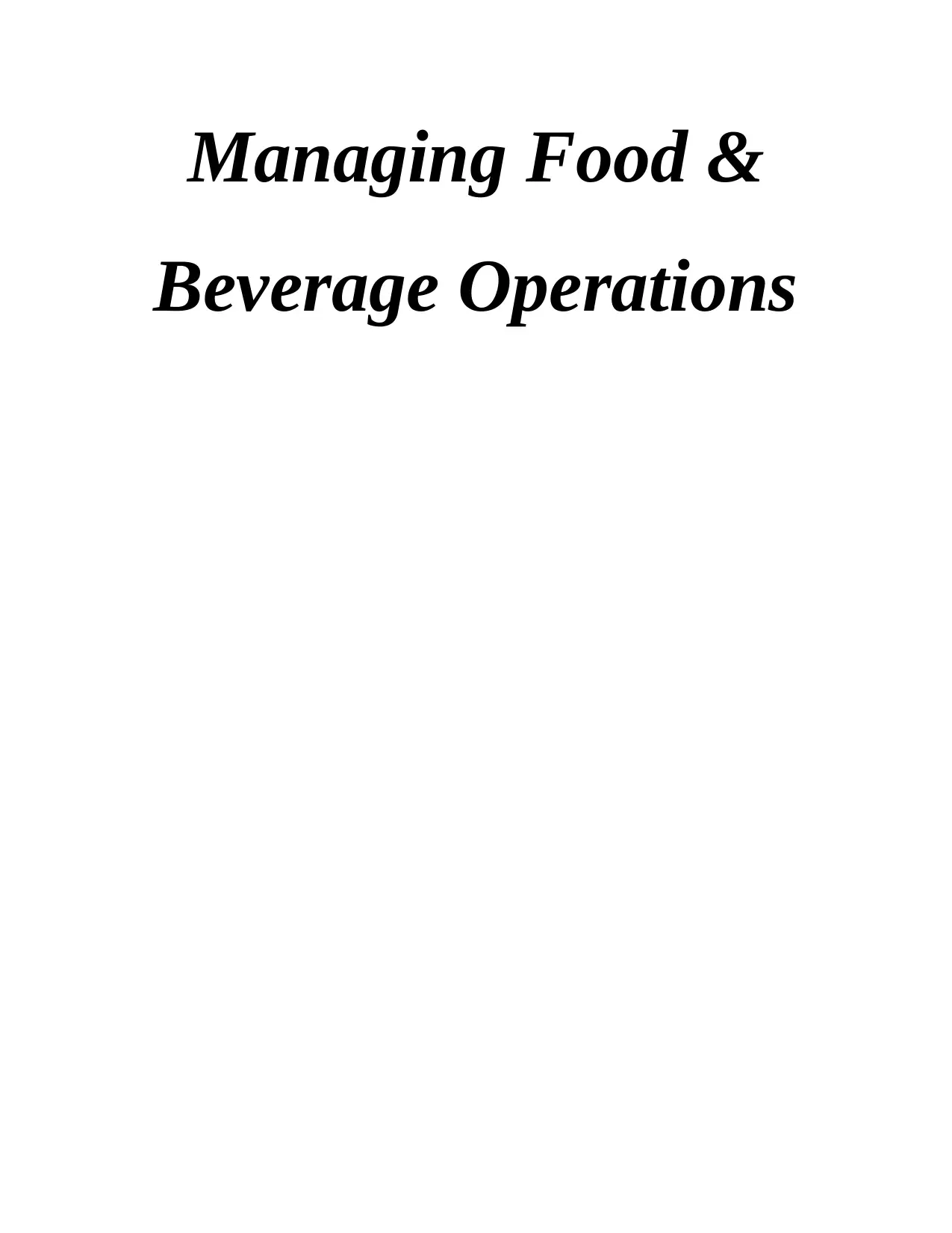
Managing Food &
Beverage Operations
Beverage Operations
Paraphrase This Document
Need a fresh take? Get an instant paraphrase of this document with our AI Paraphraser
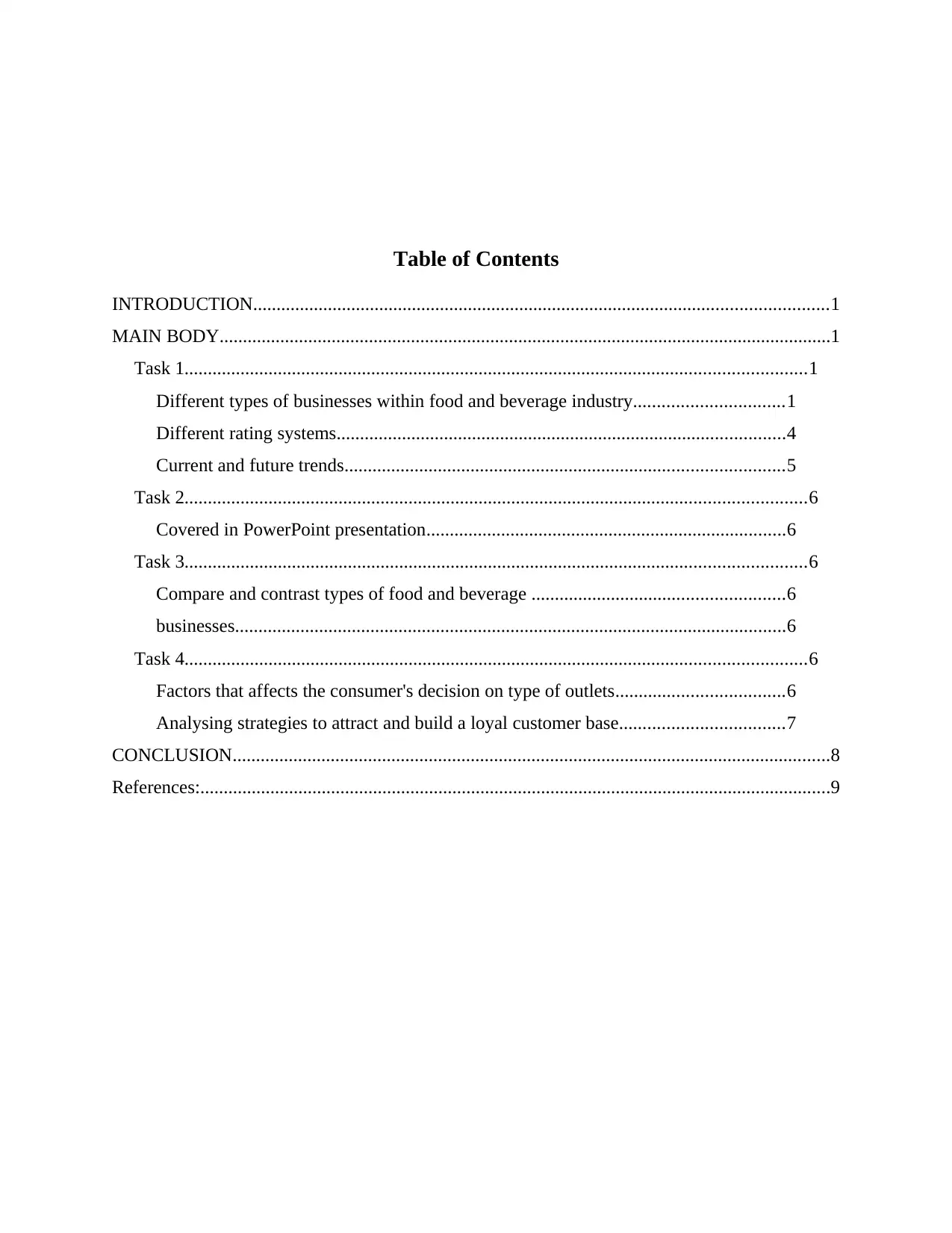
Table of Contents
INTRODUCTION...........................................................................................................................1
MAIN BODY...................................................................................................................................1
Task 1.....................................................................................................................................1
Different types of businesses within food and beverage industry................................1
Different rating systems................................................................................................4
Current and future trends..............................................................................................5
Task 2.....................................................................................................................................6
Covered in PowerPoint presentation.............................................................................6
Task 3.....................................................................................................................................6
Compare and contrast types of food and beverage ......................................................6
businesses......................................................................................................................6
Task 4.....................................................................................................................................6
Factors that affects the consumer's decision on type of outlets....................................6
Analysing strategies to attract and build a loyal customer base...................................7
CONCLUSION................................................................................................................................8
References:.......................................................................................................................................9
INTRODUCTION...........................................................................................................................1
MAIN BODY...................................................................................................................................1
Task 1.....................................................................................................................................1
Different types of businesses within food and beverage industry................................1
Different rating systems................................................................................................4
Current and future trends..............................................................................................5
Task 2.....................................................................................................................................6
Covered in PowerPoint presentation.............................................................................6
Task 3.....................................................................................................................................6
Compare and contrast types of food and beverage ......................................................6
businesses......................................................................................................................6
Task 4.....................................................................................................................................6
Factors that affects the consumer's decision on type of outlets....................................6
Analysing strategies to attract and build a loyal customer base...................................7
CONCLUSION................................................................................................................................8
References:.......................................................................................................................................9

⊘ This is a preview!⊘
Do you want full access?
Subscribe today to unlock all pages.

Trusted by 1+ million students worldwide
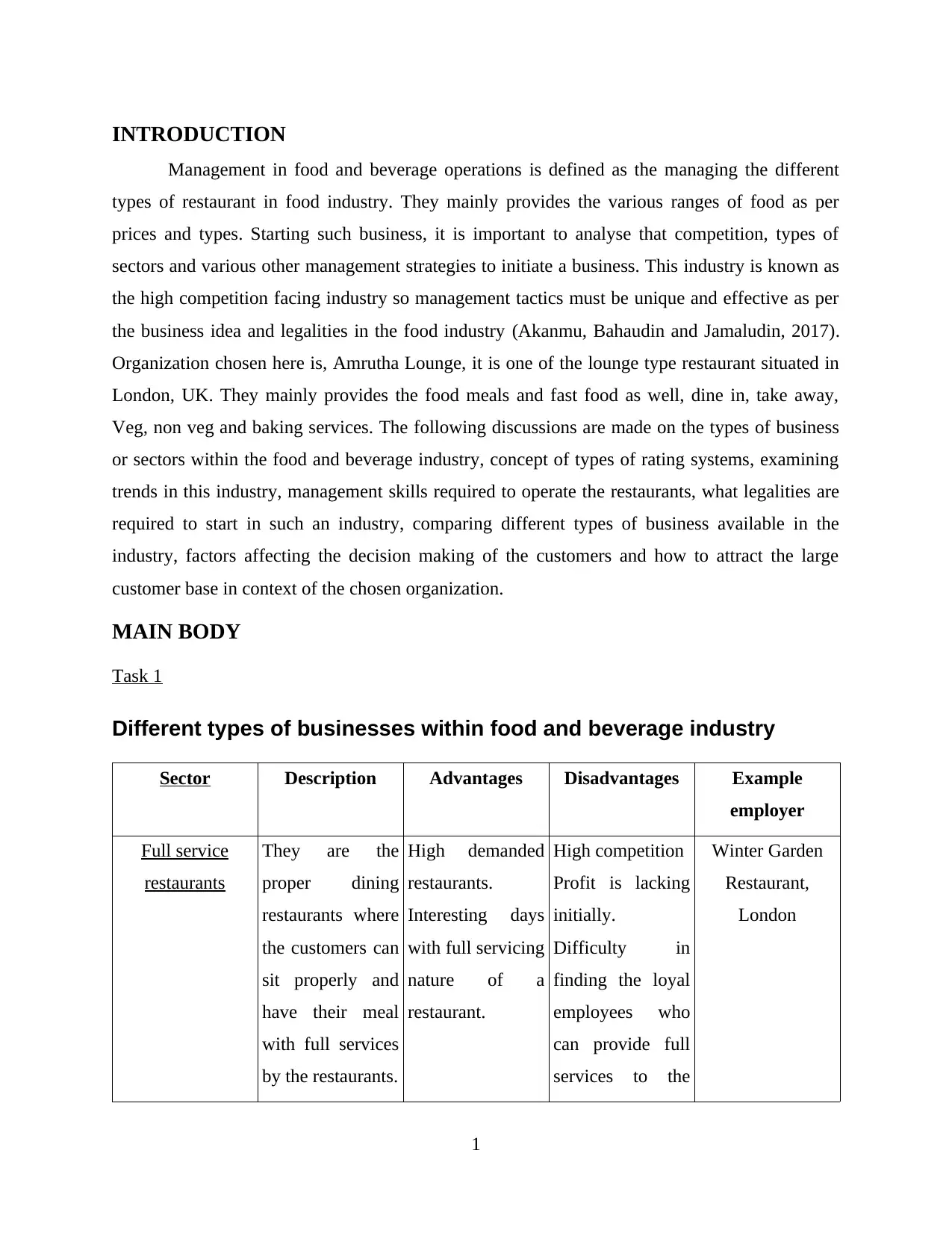
INTRODUCTION
Management in food and beverage operations is defined as the managing the different
types of restaurant in food industry. They mainly provides the various ranges of food as per
prices and types. Starting such business, it is important to analyse that competition, types of
sectors and various other management strategies to initiate a business. This industry is known as
the high competition facing industry so management tactics must be unique and effective as per
the business idea and legalities in the food industry (Akanmu, Bahaudin and Jamaludin, 2017).
Organization chosen here is, Amrutha Lounge, it is one of the lounge type restaurant situated in
London, UK. They mainly provides the food meals and fast food as well, dine in, take away,
Veg, non veg and baking services. The following discussions are made on the types of business
or sectors within the food and beverage industry, concept of types of rating systems, examining
trends in this industry, management skills required to operate the restaurants, what legalities are
required to start in such an industry, comparing different types of business available in the
industry, factors affecting the decision making of the customers and how to attract the large
customer base in context of the chosen organization.
MAIN BODY
Task 1
Different types of businesses within food and beverage industry
Sector Description Advantages Disadvantages Example
employer
Full service
restaurants
They are the
proper dining
restaurants where
the customers can
sit properly and
have their meal
with full services
by the restaurants.
High demanded
restaurants.
Interesting days
with full servicing
nature of a
restaurant.
High competition
Profit is lacking
initially.
Difficulty in
finding the loyal
employees who
can provide full
services to the
Winter Garden
Restaurant,
London
1
Management in food and beverage operations is defined as the managing the different
types of restaurant in food industry. They mainly provides the various ranges of food as per
prices and types. Starting such business, it is important to analyse that competition, types of
sectors and various other management strategies to initiate a business. This industry is known as
the high competition facing industry so management tactics must be unique and effective as per
the business idea and legalities in the food industry (Akanmu, Bahaudin and Jamaludin, 2017).
Organization chosen here is, Amrutha Lounge, it is one of the lounge type restaurant situated in
London, UK. They mainly provides the food meals and fast food as well, dine in, take away,
Veg, non veg and baking services. The following discussions are made on the types of business
or sectors within the food and beverage industry, concept of types of rating systems, examining
trends in this industry, management skills required to operate the restaurants, what legalities are
required to start in such an industry, comparing different types of business available in the
industry, factors affecting the decision making of the customers and how to attract the large
customer base in context of the chosen organization.
MAIN BODY
Task 1
Different types of businesses within food and beverage industry
Sector Description Advantages Disadvantages Example
employer
Full service
restaurants
They are the
proper dining
restaurants where
the customers can
sit properly and
have their meal
with full services
by the restaurants.
High demanded
restaurants.
Interesting days
with full servicing
nature of a
restaurant.
High competition
Profit is lacking
initially.
Difficulty in
finding the loyal
employees who
can provide full
services to the
Winter Garden
Restaurant,
London
1
Paraphrase This Document
Need a fresh take? Get an instant paraphrase of this document with our AI Paraphraser
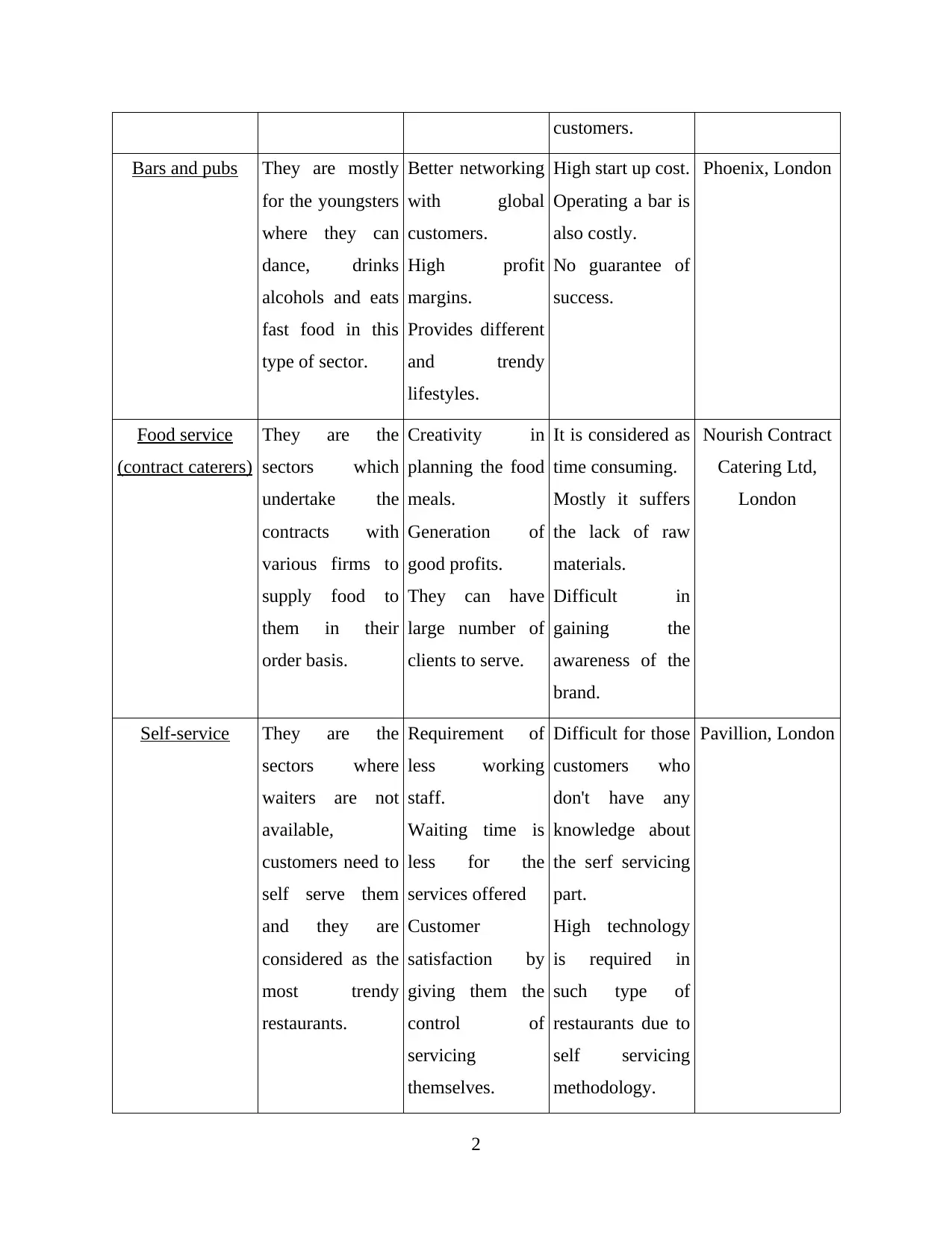
customers.
Bars and pubs They are mostly
for the youngsters
where they can
dance, drinks
alcohols and eats
fast food in this
type of sector.
Better networking
with global
customers.
High profit
margins.
Provides different
and trendy
lifestyles.
High start up cost.
Operating a bar is
also costly.
No guarantee of
success.
Phoenix, London
Food service
(contract caterers)
They are the
sectors which
undertake the
contracts with
various firms to
supply food to
them in their
order basis.
Creativity in
planning the food
meals.
Generation of
good profits.
They can have
large number of
clients to serve.
It is considered as
time consuming.
Mostly it suffers
the lack of raw
materials.
Difficult in
gaining the
awareness of the
brand.
Nourish Contract
Catering Ltd,
London
Self-service They are the
sectors where
waiters are not
available,
customers need to
self serve them
and they are
considered as the
most trendy
restaurants.
Requirement of
less working
staff.
Waiting time is
less for the
services offered
Customer
satisfaction by
giving them the
control of
servicing
themselves.
Difficult for those
customers who
don't have any
knowledge about
the serf servicing
part.
High technology
is required in
such type of
restaurants due to
self servicing
methodology.
Pavillion, London
2
Bars and pubs They are mostly
for the youngsters
where they can
dance, drinks
alcohols and eats
fast food in this
type of sector.
Better networking
with global
customers.
High profit
margins.
Provides different
and trendy
lifestyles.
High start up cost.
Operating a bar is
also costly.
No guarantee of
success.
Phoenix, London
Food service
(contract caterers)
They are the
sectors which
undertake the
contracts with
various firms to
supply food to
them in their
order basis.
Creativity in
planning the food
meals.
Generation of
good profits.
They can have
large number of
clients to serve.
It is considered as
time consuming.
Mostly it suffers
the lack of raw
materials.
Difficult in
gaining the
awareness of the
brand.
Nourish Contract
Catering Ltd,
London
Self-service They are the
sectors where
waiters are not
available,
customers need to
self serve them
and they are
considered as the
most trendy
restaurants.
Requirement of
less working
staff.
Waiting time is
less for the
services offered
Customer
satisfaction by
giving them the
control of
servicing
themselves.
Difficult for those
customers who
don't have any
knowledge about
the serf servicing
part.
High technology
is required in
such type of
restaurants due to
self servicing
methodology.
Pavillion, London
2
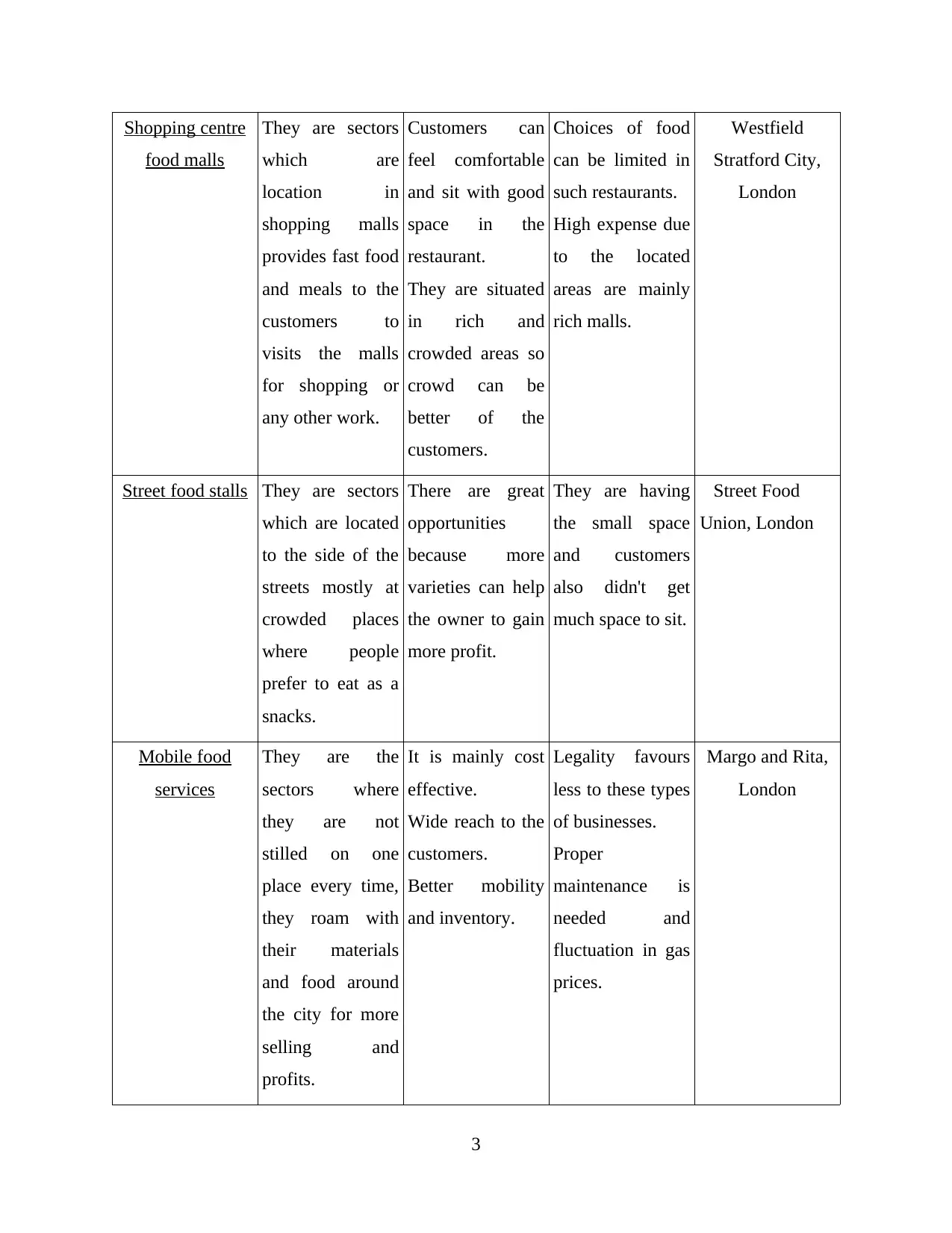
Shopping centre
food malls
They are sectors
which are
location in
shopping malls
provides fast food
and meals to the
customers to
visits the malls
for shopping or
any other work.
Customers can
feel comfortable
and sit with good
space in the
restaurant.
They are situated
in rich and
crowded areas so
crowd can be
better of the
customers.
Choices of food
can be limited in
such restaurants.
High expense due
to the located
areas are mainly
rich malls.
Westfield
Stratford City,
London
Street food stalls They are sectors
which are located
to the side of the
streets mostly at
crowded places
where people
prefer to eat as a
snacks.
There are great
opportunities
because more
varieties can help
the owner to gain
more profit.
They are having
the small space
and customers
also didn't get
much space to sit.
Street Food
Union, London
Mobile food
services
They are the
sectors where
they are not
stilled on one
place every time,
they roam with
their materials
and food around
the city for more
selling and
profits.
It is mainly cost
effective.
Wide reach to the
customers.
Better mobility
and inventory.
Legality favours
less to these types
of businesses.
Proper
maintenance is
needed and
fluctuation in gas
prices.
Margo and Rita,
London
3
food malls
They are sectors
which are
location in
shopping malls
provides fast food
and meals to the
customers to
visits the malls
for shopping or
any other work.
Customers can
feel comfortable
and sit with good
space in the
restaurant.
They are situated
in rich and
crowded areas so
crowd can be
better of the
customers.
Choices of food
can be limited in
such restaurants.
High expense due
to the located
areas are mainly
rich malls.
Westfield
Stratford City,
London
Street food stalls They are sectors
which are located
to the side of the
streets mostly at
crowded places
where people
prefer to eat as a
snacks.
There are great
opportunities
because more
varieties can help
the owner to gain
more profit.
They are having
the small space
and customers
also didn't get
much space to sit.
Street Food
Union, London
Mobile food
services
They are the
sectors where
they are not
stilled on one
place every time,
they roam with
their materials
and food around
the city for more
selling and
profits.
It is mainly cost
effective.
Wide reach to the
customers.
Better mobility
and inventory.
Legality favours
less to these types
of businesses.
Proper
maintenance is
needed and
fluctuation in gas
prices.
Margo and Rita,
London
3
⊘ This is a preview!⊘
Do you want full access?
Subscribe today to unlock all pages.

Trusted by 1+ million students worldwide
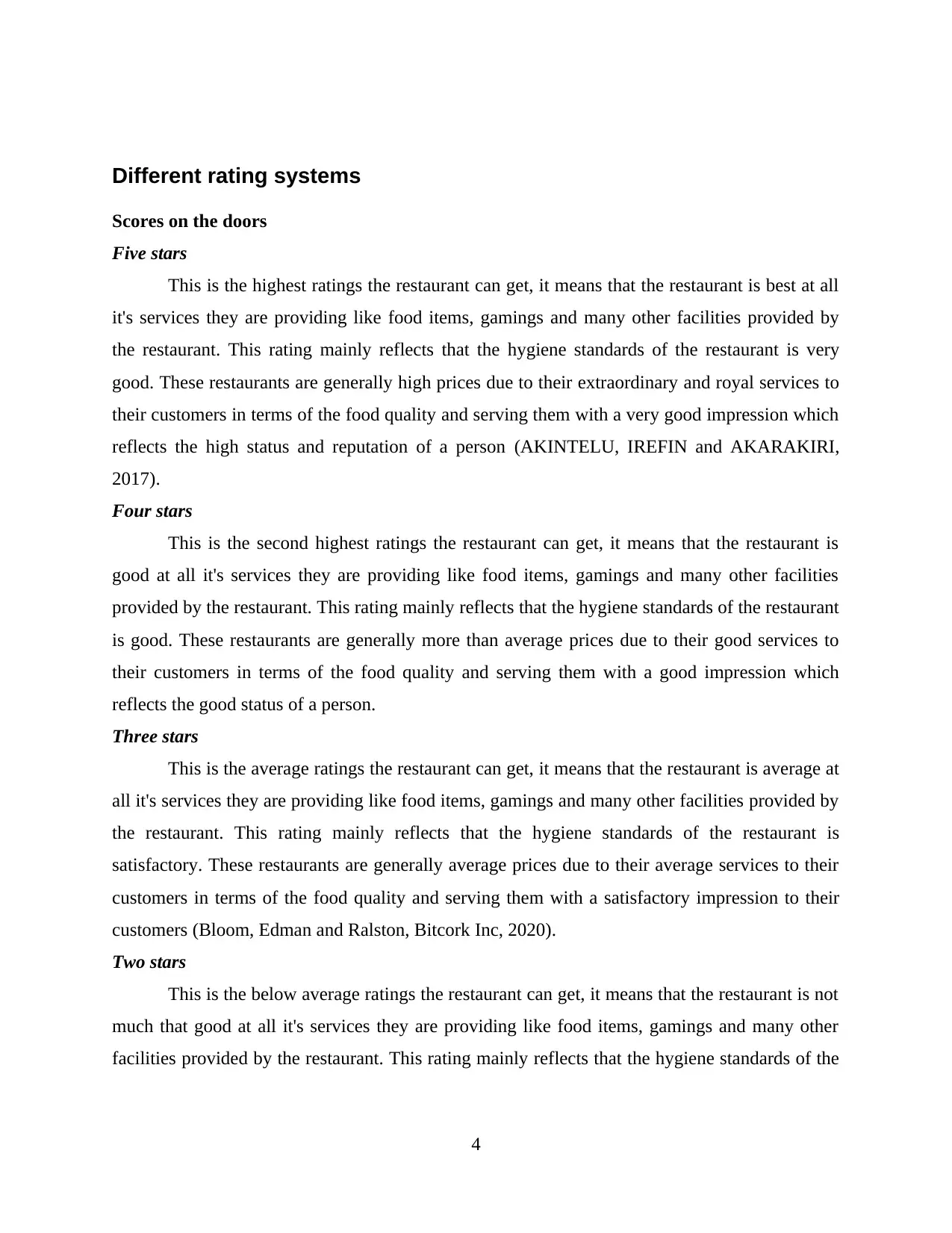
Different rating systems
Scores on the doors
Five stars
This is the highest ratings the restaurant can get, it means that the restaurant is best at all
it's services they are providing like food items, gamings and many other facilities provided by
the restaurant. This rating mainly reflects that the hygiene standards of the restaurant is very
good. These restaurants are generally high prices due to their extraordinary and royal services to
their customers in terms of the food quality and serving them with a very good impression which
reflects the high status and reputation of a person (AKINTELU, IREFIN and AKARAKIRI,
2017).
Four stars
This is the second highest ratings the restaurant can get, it means that the restaurant is
good at all it's services they are providing like food items, gamings and many other facilities
provided by the restaurant. This rating mainly reflects that the hygiene standards of the restaurant
is good. These restaurants are generally more than average prices due to their good services to
their customers in terms of the food quality and serving them with a good impression which
reflects the good status of a person.
Three stars
This is the average ratings the restaurant can get, it means that the restaurant is average at
all it's services they are providing like food items, gamings and many other facilities provided by
the restaurant. This rating mainly reflects that the hygiene standards of the restaurant is
satisfactory. These restaurants are generally average prices due to their average services to their
customers in terms of the food quality and serving them with a satisfactory impression to their
customers (Bloom, Edman and Ralston, Bitcork Inc, 2020).
Two stars
This is the below average ratings the restaurant can get, it means that the restaurant is not
much that good at all it's services they are providing like food items, gamings and many other
facilities provided by the restaurant. This rating mainly reflects that the hygiene standards of the
4
Scores on the doors
Five stars
This is the highest ratings the restaurant can get, it means that the restaurant is best at all
it's services they are providing like food items, gamings and many other facilities provided by
the restaurant. This rating mainly reflects that the hygiene standards of the restaurant is very
good. These restaurants are generally high prices due to their extraordinary and royal services to
their customers in terms of the food quality and serving them with a very good impression which
reflects the high status and reputation of a person (AKINTELU, IREFIN and AKARAKIRI,
2017).
Four stars
This is the second highest ratings the restaurant can get, it means that the restaurant is
good at all it's services they are providing like food items, gamings and many other facilities
provided by the restaurant. This rating mainly reflects that the hygiene standards of the restaurant
is good. These restaurants are generally more than average prices due to their good services to
their customers in terms of the food quality and serving them with a good impression which
reflects the good status of a person.
Three stars
This is the average ratings the restaurant can get, it means that the restaurant is average at
all it's services they are providing like food items, gamings and many other facilities provided by
the restaurant. This rating mainly reflects that the hygiene standards of the restaurant is
satisfactory. These restaurants are generally average prices due to their average services to their
customers in terms of the food quality and serving them with a satisfactory impression to their
customers (Bloom, Edman and Ralston, Bitcork Inc, 2020).
Two stars
This is the below average ratings the restaurant can get, it means that the restaurant is not
much that good at all it's services they are providing like food items, gamings and many other
facilities provided by the restaurant. This rating mainly reflects that the hygiene standards of the
4
Paraphrase This Document
Need a fresh take? Get an instant paraphrase of this document with our AI Paraphraser
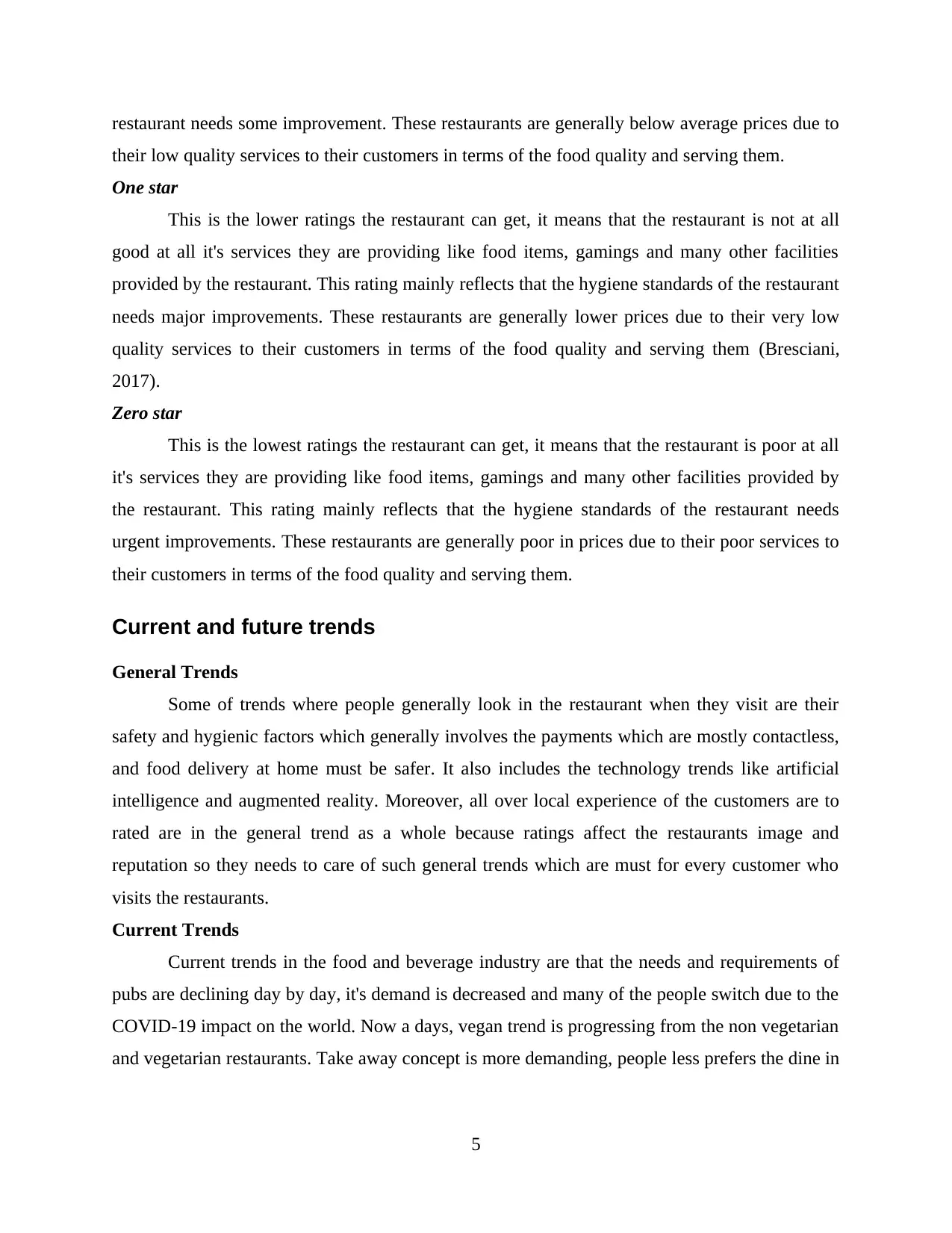
restaurant needs some improvement. These restaurants are generally below average prices due to
their low quality services to their customers in terms of the food quality and serving them.
One star
This is the lower ratings the restaurant can get, it means that the restaurant is not at all
good at all it's services they are providing like food items, gamings and many other facilities
provided by the restaurant. This rating mainly reflects that the hygiene standards of the restaurant
needs major improvements. These restaurants are generally lower prices due to their very low
quality services to their customers in terms of the food quality and serving them (Bresciani,
2017).
Zero star
This is the lowest ratings the restaurant can get, it means that the restaurant is poor at all
it's services they are providing like food items, gamings and many other facilities provided by
the restaurant. This rating mainly reflects that the hygiene standards of the restaurant needs
urgent improvements. These restaurants are generally poor in prices due to their poor services to
their customers in terms of the food quality and serving them.
Current and future trends
General Trends
Some of trends where people generally look in the restaurant when they visit are their
safety and hygienic factors which generally involves the payments which are mostly contactless,
and food delivery at home must be safer. It also includes the technology trends like artificial
intelligence and augmented reality. Moreover, all over local experience of the customers are to
rated are in the general trend as a whole because ratings affect the restaurants image and
reputation so they needs to care of such general trends which are must for every customer who
visits the restaurants.
Current Trends
Current trends in the food and beverage industry are that the needs and requirements of
pubs are declining day by day, it's demand is decreased and many of the people switch due to the
COVID-19 impact on the world. Now a days, vegan trend is progressing from the non vegetarian
and vegetarian restaurants. Take away concept is more demanding, people less prefers the dine in
5
their low quality services to their customers in terms of the food quality and serving them.
One star
This is the lower ratings the restaurant can get, it means that the restaurant is not at all
good at all it's services they are providing like food items, gamings and many other facilities
provided by the restaurant. This rating mainly reflects that the hygiene standards of the restaurant
needs major improvements. These restaurants are generally lower prices due to their very low
quality services to their customers in terms of the food quality and serving them (Bresciani,
2017).
Zero star
This is the lowest ratings the restaurant can get, it means that the restaurant is poor at all
it's services they are providing like food items, gamings and many other facilities provided by
the restaurant. This rating mainly reflects that the hygiene standards of the restaurant needs
urgent improvements. These restaurants are generally poor in prices due to their poor services to
their customers in terms of the food quality and serving them.
Current and future trends
General Trends
Some of trends where people generally look in the restaurant when they visit are their
safety and hygienic factors which generally involves the payments which are mostly contactless,
and food delivery at home must be safer. It also includes the technology trends like artificial
intelligence and augmented reality. Moreover, all over local experience of the customers are to
rated are in the general trend as a whole because ratings affect the restaurants image and
reputation so they needs to care of such general trends which are must for every customer who
visits the restaurants.
Current Trends
Current trends in the food and beverage industry are that the needs and requirements of
pubs are declining day by day, it's demand is decreased and many of the people switch due to the
COVID-19 impact on the world. Now a days, vegan trend is progressing from the non vegetarian
and vegetarian restaurants. Take away concept is more demanding, people less prefers the dine in
5
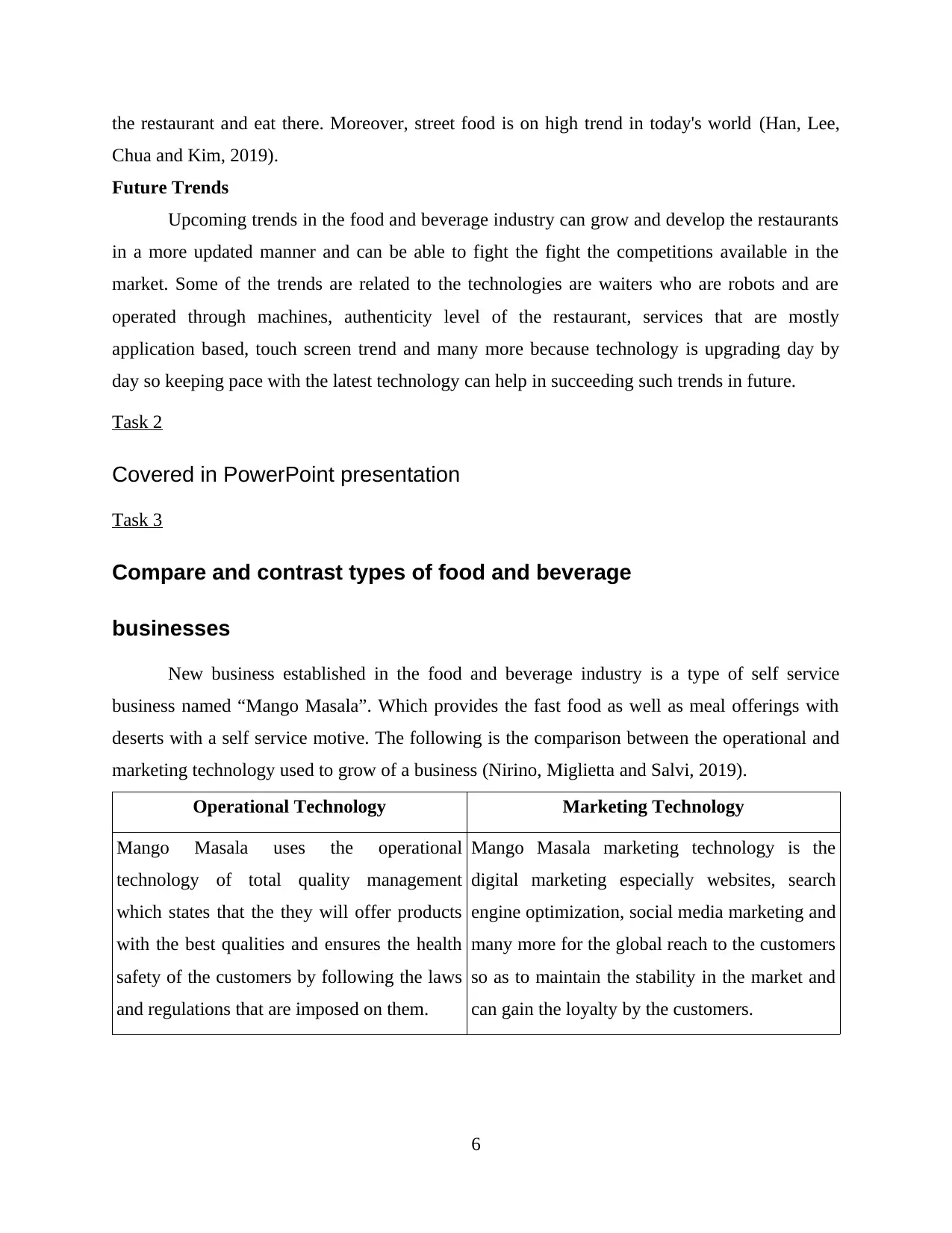
the restaurant and eat there. Moreover, street food is on high trend in today's world (Han, Lee,
Chua and Kim, 2019).
Future Trends
Upcoming trends in the food and beverage industry can grow and develop the restaurants
in a more updated manner and can be able to fight the fight the competitions available in the
market. Some of the trends are related to the technologies are waiters who are robots and are
operated through machines, authenticity level of the restaurant, services that are mostly
application based, touch screen trend and many more because technology is upgrading day by
day so keeping pace with the latest technology can help in succeeding such trends in future.
Task 2
Covered in PowerPoint presentation
Task 3
Compare and contrast types of food and beverage
businesses
New business established in the food and beverage industry is a type of self service
business named “Mango Masala”. Which provides the fast food as well as meal offerings with
deserts with a self service motive. The following is the comparison between the operational and
marketing technology used to grow of a business (Nirino, Miglietta and Salvi, 2019).
Operational Technology Marketing Technology
Mango Masala uses the operational
technology of total quality management
which states that the they will offer products
with the best qualities and ensures the health
safety of the customers by following the laws
and regulations that are imposed on them.
Mango Masala marketing technology is the
digital marketing especially websites, search
engine optimization, social media marketing and
many more for the global reach to the customers
so as to maintain the stability in the market and
can gain the loyalty by the customers.
6
Chua and Kim, 2019).
Future Trends
Upcoming trends in the food and beverage industry can grow and develop the restaurants
in a more updated manner and can be able to fight the fight the competitions available in the
market. Some of the trends are related to the technologies are waiters who are robots and are
operated through machines, authenticity level of the restaurant, services that are mostly
application based, touch screen trend and many more because technology is upgrading day by
day so keeping pace with the latest technology can help in succeeding such trends in future.
Task 2
Covered in PowerPoint presentation
Task 3
Compare and contrast types of food and beverage
businesses
New business established in the food and beverage industry is a type of self service
business named “Mango Masala”. Which provides the fast food as well as meal offerings with
deserts with a self service motive. The following is the comparison between the operational and
marketing technology used to grow of a business (Nirino, Miglietta and Salvi, 2019).
Operational Technology Marketing Technology
Mango Masala uses the operational
technology of total quality management
which states that the they will offer products
with the best qualities and ensures the health
safety of the customers by following the laws
and regulations that are imposed on them.
Mango Masala marketing technology is the
digital marketing especially websites, search
engine optimization, social media marketing and
many more for the global reach to the customers
so as to maintain the stability in the market and
can gain the loyalty by the customers.
6
⊘ This is a preview!⊘
Do you want full access?
Subscribe today to unlock all pages.

Trusted by 1+ million students worldwide
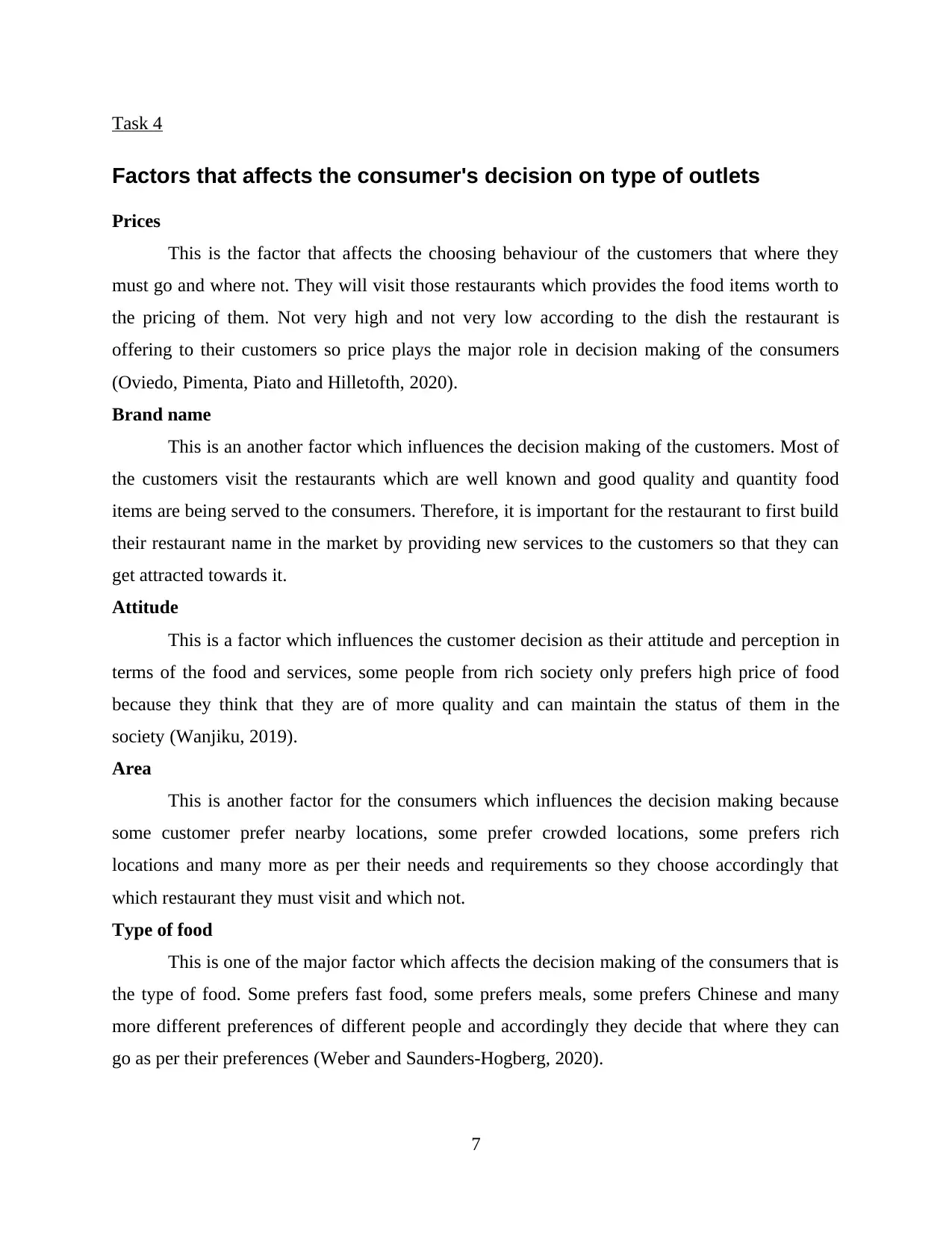
Task 4
Factors that affects the consumer's decision on type of outlets
Prices
This is the factor that affects the choosing behaviour of the customers that where they
must go and where not. They will visit those restaurants which provides the food items worth to
the pricing of them. Not very high and not very low according to the dish the restaurant is
offering to their customers so price plays the major role in decision making of the consumers
(Oviedo, Pimenta, Piato and Hilletofth, 2020).
Brand name
This is an another factor which influences the decision making of the customers. Most of
the customers visit the restaurants which are well known and good quality and quantity food
items are being served to the consumers. Therefore, it is important for the restaurant to first build
their restaurant name in the market by providing new services to the customers so that they can
get attracted towards it.
Attitude
This is a factor which influences the customer decision as their attitude and perception in
terms of the food and services, some people from rich society only prefers high price of food
because they think that they are of more quality and can maintain the status of them in the
society (Wanjiku, 2019).
Area
This is another factor for the consumers which influences the decision making because
some customer prefer nearby locations, some prefer crowded locations, some prefers rich
locations and many more as per their needs and requirements so they choose accordingly that
which restaurant they must visit and which not.
Type of food
This is one of the major factor which affects the decision making of the consumers that is
the type of food. Some prefers fast food, some prefers meals, some prefers Chinese and many
more different preferences of different people and accordingly they decide that where they can
go as per their preferences (Weber and Saunders‐Hogberg, 2020).
7
Factors that affects the consumer's decision on type of outlets
Prices
This is the factor that affects the choosing behaviour of the customers that where they
must go and where not. They will visit those restaurants which provides the food items worth to
the pricing of them. Not very high and not very low according to the dish the restaurant is
offering to their customers so price plays the major role in decision making of the consumers
(Oviedo, Pimenta, Piato and Hilletofth, 2020).
Brand name
This is an another factor which influences the decision making of the customers. Most of
the customers visit the restaurants which are well known and good quality and quantity food
items are being served to the consumers. Therefore, it is important for the restaurant to first build
their restaurant name in the market by providing new services to the customers so that they can
get attracted towards it.
Attitude
This is a factor which influences the customer decision as their attitude and perception in
terms of the food and services, some people from rich society only prefers high price of food
because they think that they are of more quality and can maintain the status of them in the
society (Wanjiku, 2019).
Area
This is another factor for the consumers which influences the decision making because
some customer prefer nearby locations, some prefer crowded locations, some prefers rich
locations and many more as per their needs and requirements so they choose accordingly that
which restaurant they must visit and which not.
Type of food
This is one of the major factor which affects the decision making of the consumers that is
the type of food. Some prefers fast food, some prefers meals, some prefers Chinese and many
more different preferences of different people and accordingly they decide that where they can
go as per their preferences (Weber and Saunders‐Hogberg, 2020).
7
Paraphrase This Document
Need a fresh take? Get an instant paraphrase of this document with our AI Paraphraser
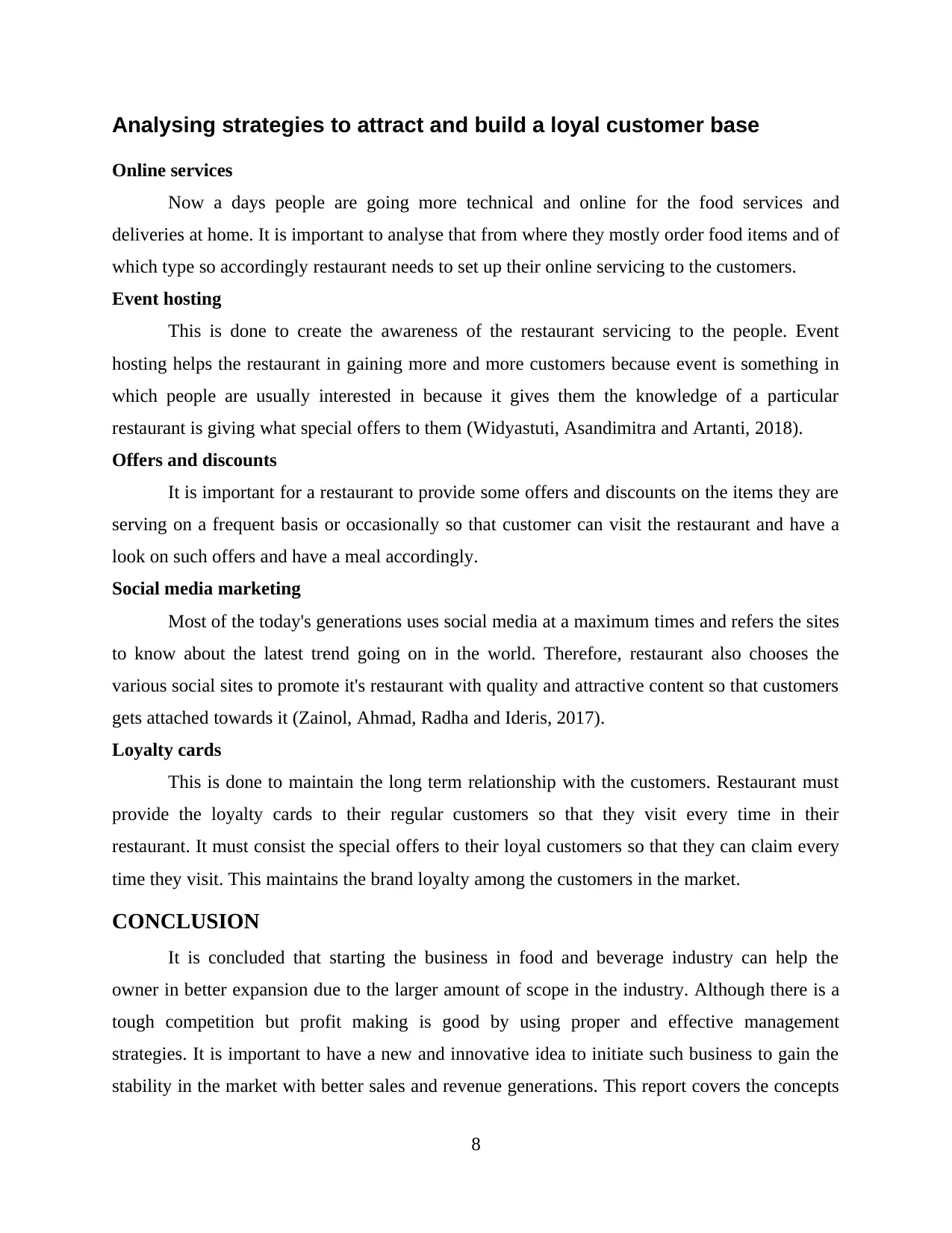
Analysing strategies to attract and build a loyal customer base
Online services
Now a days people are going more technical and online for the food services and
deliveries at home. It is important to analyse that from where they mostly order food items and of
which type so accordingly restaurant needs to set up their online servicing to the customers.
Event hosting
This is done to create the awareness of the restaurant servicing to the people. Event
hosting helps the restaurant in gaining more and more customers because event is something in
which people are usually interested in because it gives them the knowledge of a particular
restaurant is giving what special offers to them (Widyastuti, Asandimitra and Artanti, 2018).
Offers and discounts
It is important for a restaurant to provide some offers and discounts on the items they are
serving on a frequent basis or occasionally so that customer can visit the restaurant and have a
look on such offers and have a meal accordingly.
Social media marketing
Most of the today's generations uses social media at a maximum times and refers the sites
to know about the latest trend going on in the world. Therefore, restaurant also chooses the
various social sites to promote it's restaurant with quality and attractive content so that customers
gets attached towards it (Zainol, Ahmad, Radha and Ideris, 2017).
Loyalty cards
This is done to maintain the long term relationship with the customers. Restaurant must
provide the loyalty cards to their regular customers so that they visit every time in their
restaurant. It must consist the special offers to their loyal customers so that they can claim every
time they visit. This maintains the brand loyalty among the customers in the market.
CONCLUSION
It is concluded that starting the business in food and beverage industry can help the
owner in better expansion due to the larger amount of scope in the industry. Although there is a
tough competition but profit making is good by using proper and effective management
strategies. It is important to have a new and innovative idea to initiate such business to gain the
stability in the market with better sales and revenue generations. This report covers the concepts
8
Online services
Now a days people are going more technical and online for the food services and
deliveries at home. It is important to analyse that from where they mostly order food items and of
which type so accordingly restaurant needs to set up their online servicing to the customers.
Event hosting
This is done to create the awareness of the restaurant servicing to the people. Event
hosting helps the restaurant in gaining more and more customers because event is something in
which people are usually interested in because it gives them the knowledge of a particular
restaurant is giving what special offers to them (Widyastuti, Asandimitra and Artanti, 2018).
Offers and discounts
It is important for a restaurant to provide some offers and discounts on the items they are
serving on a frequent basis or occasionally so that customer can visit the restaurant and have a
look on such offers and have a meal accordingly.
Social media marketing
Most of the today's generations uses social media at a maximum times and refers the sites
to know about the latest trend going on in the world. Therefore, restaurant also chooses the
various social sites to promote it's restaurant with quality and attractive content so that customers
gets attached towards it (Zainol, Ahmad, Radha and Ideris, 2017).
Loyalty cards
This is done to maintain the long term relationship with the customers. Restaurant must
provide the loyalty cards to their regular customers so that they visit every time in their
restaurant. It must consist the special offers to their loyal customers so that they can claim every
time they visit. This maintains the brand loyalty among the customers in the market.
CONCLUSION
It is concluded that starting the business in food and beverage industry can help the
owner in better expansion due to the larger amount of scope in the industry. Although there is a
tough competition but profit making is good by using proper and effective management
strategies. It is important to have a new and innovative idea to initiate such business to gain the
stability in the market with better sales and revenue generations. This report covers the concepts
8
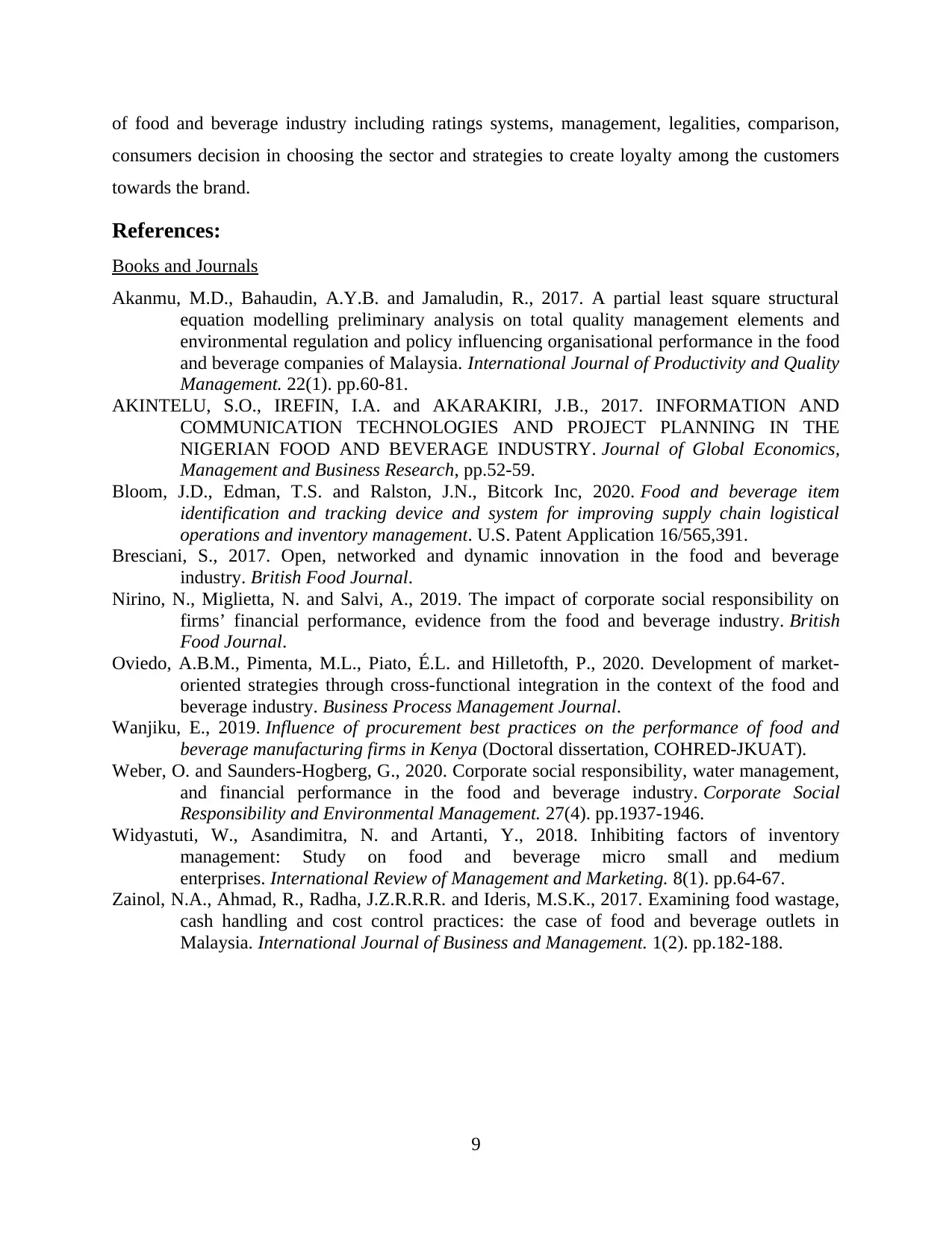
of food and beverage industry including ratings systems, management, legalities, comparison,
consumers decision in choosing the sector and strategies to create loyalty among the customers
towards the brand.
References:
Books and Journals
Akanmu, M.D., Bahaudin, A.Y.B. and Jamaludin, R., 2017. A partial least square structural
equation modelling preliminary analysis on total quality management elements and
environmental regulation and policy influencing organisational performance in the food
and beverage companies of Malaysia. International Journal of Productivity and Quality
Management. 22(1). pp.60-81.
AKINTELU, S.O., IREFIN, I.A. and AKARAKIRI, J.B., 2017. INFORMATION AND
COMMUNICATION TECHNOLOGIES AND PROJECT PLANNING IN THE
NIGERIAN FOOD AND BEVERAGE INDUSTRY. Journal of Global Economics,
Management and Business Research, pp.52-59.
Bloom, J.D., Edman, T.S. and Ralston, J.N., Bitcork Inc, 2020. Food and beverage item
identification and tracking device and system for improving supply chain logistical
operations and inventory management. U.S. Patent Application 16/565,391.
Bresciani, S., 2017. Open, networked and dynamic innovation in the food and beverage
industry. British Food Journal.
Nirino, N., Miglietta, N. and Salvi, A., 2019. The impact of corporate social responsibility on
firms’ financial performance, evidence from the food and beverage industry. British
Food Journal.
Oviedo, A.B.M., Pimenta, M.L., Piato, É.L. and Hilletofth, P., 2020. Development of market-
oriented strategies through cross-functional integration in the context of the food and
beverage industry. Business Process Management Journal.
Wanjiku, E., 2019. Influence of procurement best practices on the performance of food and
beverage manufacturing firms in Kenya (Doctoral dissertation, COHRED-JKUAT).
Weber, O. and Saunders‐Hogberg, G., 2020. Corporate social responsibility, water management,
and financial performance in the food and beverage industry. Corporate Social
Responsibility and Environmental Management. 27(4). pp.1937-1946.
Widyastuti, W., Asandimitra, N. and Artanti, Y., 2018. Inhibiting factors of inventory
management: Study on food and beverage micro small and medium
enterprises. International Review of Management and Marketing. 8(1). pp.64-67.
Zainol, N.A., Ahmad, R., Radha, J.Z.R.R.R. and Ideris, M.S.K., 2017. Examining food wastage,
cash handling and cost control practices: the case of food and beverage outlets in
Malaysia. International Journal of Business and Management. 1(2). pp.182-188.
9
consumers decision in choosing the sector and strategies to create loyalty among the customers
towards the brand.
References:
Books and Journals
Akanmu, M.D., Bahaudin, A.Y.B. and Jamaludin, R., 2017. A partial least square structural
equation modelling preliminary analysis on total quality management elements and
environmental regulation and policy influencing organisational performance in the food
and beverage companies of Malaysia. International Journal of Productivity and Quality
Management. 22(1). pp.60-81.
AKINTELU, S.O., IREFIN, I.A. and AKARAKIRI, J.B., 2017. INFORMATION AND
COMMUNICATION TECHNOLOGIES AND PROJECT PLANNING IN THE
NIGERIAN FOOD AND BEVERAGE INDUSTRY. Journal of Global Economics,
Management and Business Research, pp.52-59.
Bloom, J.D., Edman, T.S. and Ralston, J.N., Bitcork Inc, 2020. Food and beverage item
identification and tracking device and system for improving supply chain logistical
operations and inventory management. U.S. Patent Application 16/565,391.
Bresciani, S., 2017. Open, networked and dynamic innovation in the food and beverage
industry. British Food Journal.
Nirino, N., Miglietta, N. and Salvi, A., 2019. The impact of corporate social responsibility on
firms’ financial performance, evidence from the food and beverage industry. British
Food Journal.
Oviedo, A.B.M., Pimenta, M.L., Piato, É.L. and Hilletofth, P., 2020. Development of market-
oriented strategies through cross-functional integration in the context of the food and
beverage industry. Business Process Management Journal.
Wanjiku, E., 2019. Influence of procurement best practices on the performance of food and
beverage manufacturing firms in Kenya (Doctoral dissertation, COHRED-JKUAT).
Weber, O. and Saunders‐Hogberg, G., 2020. Corporate social responsibility, water management,
and financial performance in the food and beverage industry. Corporate Social
Responsibility and Environmental Management. 27(4). pp.1937-1946.
Widyastuti, W., Asandimitra, N. and Artanti, Y., 2018. Inhibiting factors of inventory
management: Study on food and beverage micro small and medium
enterprises. International Review of Management and Marketing. 8(1). pp.64-67.
Zainol, N.A., Ahmad, R., Radha, J.Z.R.R.R. and Ideris, M.S.K., 2017. Examining food wastage,
cash handling and cost control practices: the case of food and beverage outlets in
Malaysia. International Journal of Business and Management. 1(2). pp.182-188.
9
⊘ This is a preview!⊘
Do you want full access?
Subscribe today to unlock all pages.

Trusted by 1+ million students worldwide
1 out of 12
Related Documents
Your All-in-One AI-Powered Toolkit for Academic Success.
+13062052269
info@desklib.com
Available 24*7 on WhatsApp / Email
![[object Object]](/_next/static/media/star-bottom.7253800d.svg)
Unlock your academic potential
Copyright © 2020–2025 A2Z Services. All Rights Reserved. Developed and managed by ZUCOL.





